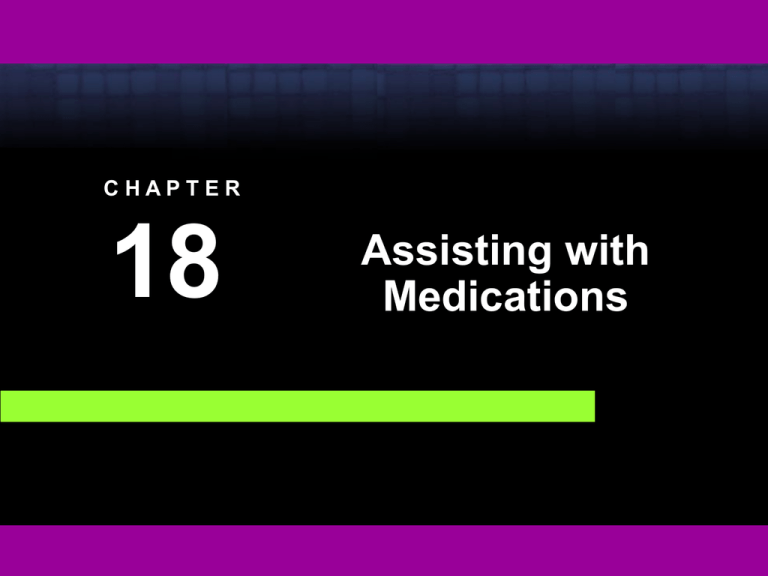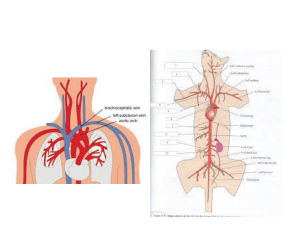
CHAPTER
18
Assisting with
Medications
UNIT
1
Prescription and
Nonprescription
Medications
18 - 2
Copyright © 2008 Thomson Delmar Learning, a division of Thomson Learning Inc. All rights reserved.
How to Use the PDR
The Physicians’ Desk Reference is
divided into sections:
Section 1 (white pages)
18 - 3
Manufacturers index includes an alphabetical
listing of all manufacturers and a listing of their
products
(continued)
Copyright © 2008 Thomson Delmar Learning, a division of Thomson Learning Inc. All rights reserved.
How to Use the PDR
Section 2 (pink pages)
Section 3 (blue pages)
Product category index
Section 4 (gray pages)
Brand and generic name index
Product identification section
Section 5 (white pages)
Product information section
18 - 4
Copyright © 2008 Thomson Delmar Learning, a division of Thomson Learning Inc. All rights reserved.
Section 5: Categories
Brand name
Generic name
Description
Clinical
pharmacology
Indications and
usage
Contraindications
Warnings
Precautions
Adverse
reactions
Dosage and
administration
How supplied
18 - 5
Copyright © 2008 Thomson Delmar Learning, a division of Thomson Learning Inc. All rights reserved.
How to Use the PDR
Section 6 (green pages)
Diagnostic product information includes
guidelines for common diagnostic agents
and:
Key to Controlled Substance Categories
Key to FDA Use-in-Pregnancy Ratings
U.S. Food and Drug Administration
Phone Directory
Poison Control Centers
Listing of Discontinued Products
Adverse Event Report Form (MedWatch)
18 - 6
Copyright © 2008 Thomson Delmar Learning, a division of Thomson Learning Inc. All rights reserved.
Drug Classifications
Drugs that prevent disease
Drugs that have a particular action
Example: analgesics
Drugs that have a target effect
18 - 7
Immunizations and vaccinations
Example: cardiac drugs
(continued)
Copyright © 2008 Thomson Delmar Learning, a division of Thomson Learning Inc. All rights reserved.
Drug Classifications
How drugs are prepared
Example: tablet, liquid, capsules, etc.
Refer to Table 18-1
18 - 8
Copyright © 2008 Thomson Delmar Learning, a division of Thomson Learning Inc. All rights reserved.
Drug Actions
Drugs can act in three ways in the body:
1.
2.
3.
Directly affect one or more body tissues
Affect microorganisms
Replace a body chemical
18 - 9
Copyright © 2008 Thomson Delmar Learning, a division of Thomson Learning Inc. All rights reserved.
Classifications of Drug Actions
Local
Remote
18 - 10
Action occurs where administered
Action occurs away from where it was
administered
(continued)
Copyright © 2008 Thomson Delmar Learning, a division of Thomson Learning Inc. All rights reserved.
Classifications of Drug Actions
Systemic
Action takes place throughout the body
Synergistic
One drug may work with or counteract
another drug
18 - 11
Copyright © 2008 Thomson Delmar Learning, a division of Thomson Learning Inc. All rights reserved.
Parts of a Prescription
1.
2.
3.
4.
5.
6.
7.
8.
9.
Physician’s information
Patient’s information
Superscription
Inscription
Subscription
Signature
Physician’s signature
Repetatur 0 1 2 3 PRN
Label
18 - 12
Copyright © 2008 Thomson Delmar Learning, a division of Thomson Learning Inc. All rights reserved.
Phoning In Prescriptions
When phoning in prescriptions, the
medical assistant must include all the
information listed in the written
prescription.
To ensure accuracy, the medical
assistant should always ask the
pharmacist to repeat the information
given.
18 - 13
Copyright © 2008 Thomson Delmar Learning, a division of Thomson Learning Inc. All rights reserved.
Federal Regulations
18 - 14
Any physician that prescribes,
dispenses, or administers medications
must register with the U.S. Department
of Justice, Drug Enforcement
Administration (DEA) under the
Controlled Substances Act of 1970.
(continued)
Copyright © 2008 Thomson Delmar Learning, a division of Thomson Learning Inc. All rights reserved.
Federal Regulations
Physicians must complete the necessary
form that provides their state license
number and signature every 3 years.
Physicians must pay a fee.
The physician must report any change of
address to the nearest DEA office.
18 - 15
Copyright © 2008 Thomson Delmar Learning, a division of Thomson Learning Inc. All rights reserved.
Schedule of Controlled Substances
Schedule I
No recognized medicinal use in the U.S.
Schedule II
Must have written or typed prescription
with physician’s signature; may not be
refilled
Schedule III
Prescriptions may be written or phoned
in; up to 5 refills in 6 months.
Schedule IV
Up to 5 refills in 6 months
Schedule V
Subject to state and local regulations;
prescription may not be required.
18 - 16
Copyright © 2008 Thomson Delmar Learning, a division of Thomson Learning Inc. All rights reserved.
Commonly Used Abbreviations
Refer to Table 18-3
Refer to Appendix E for abbreviations on
the Joint Commission’s Do Not Use List,
and the Institute for Safe Medication
Practice’s Error-Prone Abbreviation List.
18 - 17
Copyright © 2008 Thomson Delmar Learning, a division of Thomson Learning Inc. All rights reserved.
Recording Medication in
the Patient’s Chart
Charting must include the following:
Who ordered the medication
What medication was ordered: include how
much is to be given by listing the strength
and dose of the medication
What date is the medication to be
administered
How is the medication to be taken
Record oral, sublingual, topical, or parenteral
18 - 18
Copyright © 2008 Thomson Delmar Learning, a division of Thomson Learning Inc. All rights reserved.
Medical, Legal, and Ethical Concerns
18 - 19
Know federal and state laws that
manage controlled substances.
Keep a thorough record and inventory of
all drugs and samples.
Keep all drugs in a secure location.
(continued)
Copyright © 2008 Thomson Delmar Learning, a division of Thomson Learning Inc. All rights reserved.
Medical, Legal, and Ethical Concerns
Remind the physician of DEA registration
and renewal dates.
Keep track of all prescription pads.
Properly dispose of expired drugs and
keep a record of their disposal.
18 - 20
Copyright © 2008 Thomson Delmar Learning, a division of Thomson Learning Inc. All rights reserved.
Unit Summary
What is included in the white pages of
the PDR?
What are drug classifications?
Why would you begin in the pink section
of the PDR?
18 - 21
Copyright © 2008 Thomson Delmar Learning, a division of Thomson Learning Inc. All rights reserved.
UNIT
2
Methods of
Administering
Medications
18 - 22
Copyright © 2008 Thomson Delmar Learning, a division of Thomson Learning Inc. All rights reserved.
The Importance of Checking Medications
Make sure you have the right:
Patient
Medication
Dose and amount
Route and method
Technique
Time and schedule
18 - 23
Copyright © 2008 Thomson Delmar Learning, a division of Thomson Learning Inc. All rights reserved.
Methods of Drug Administration
Oral
Sublingual
Buccal
Inhalers
Topical
Sprays
Transdermal
Suppositories
18 - 24
Copyright © 2008 Thomson Delmar Learning, a division of Thomson Learning Inc. All rights reserved.
Considerations regarding
Drug Actions
Patient’s age
Patient’s weight
Body surface area
Method of administration
Tolerance
Patient allergies
Time
Drug interactions
18 - 25
Copyright © 2008 Thomson Delmar Learning, a division of Thomson Learning Inc. All rights reserved.
Precautions in Applying
a Transdermal Patch
Be careful to avoid getting medication on
your hands while applying the patch.
If medication gets on your hands, wash
them immediately.
Wear gloves, if possible.
18 - 26
Copyright © 2008 Thomson Delmar Learning, a division of Thomson Learning Inc. All rights reserved.
Unit Summary
What is the importance of checking
medications?
Can you identify the eight methods of
drug administration?
18 - 27
Copyright © 2008 Thomson Delmar Learning, a division of Thomson Learning Inc. All rights reserved.
UNIT
3
Injections and
Immunizations
18 - 28
Copyright © 2008 Thomson Delmar Learning, a division of Thomson Learning Inc. All rights reserved.
Parts of the Needle and Syringe
18 - 29
Copyright © 2008 Thomson Delmar Learning, a division of Thomson Learning Inc. All rights reserved.
Tissue Layers
Intradermal
Subcutaneous
Middle layer filled with
nerves and blood
vessels
Intramuscular
Immediately under the
skin
Into the muscle
Intravenous
Into the veins
18 - 30
Copyright © 2008 Thomson Delmar Learning, a division of Thomson Learning Inc. All rights reserved.
Injection Sites
18 - 31
Copyright © 2008 Thomson Delmar Learning, a division of Thomson Learning Inc. All rights reserved.
Benefits and Risks of Immunizations
Benefits
Immunizations protect against illnesses that
can prove to be very serious.
Risks
The patient could have a reaction to the
immunization.
18 - 32
Copyright © 2008 Thomson Delmar Learning, a division of Thomson Learning Inc. All rights reserved.
The Theory of IV Therapy
Direct administration of fluid into the
patient’s system
Used in unconscious patients
Used in emergencies
Direct absorption of medication into the
patient’s system
Provides an alternate route for drugs
Used when patient has gastrointestinal
difficulties
18 - 33
Copyright © 2008 Thomson Delmar Learning, a division of Thomson Learning Inc. All rights reserved.
Unit Summary
What location would be used for an
intradermal injection?
Where would you give an intramuscular
injection?
What are the benefits of immunizations?
18 - 34
Copyright © 2008 Thomson Delmar Learning, a division of Thomson Learning Inc. All rights reserved.
Keys to Career Success
The successful medical assistant makes
it a point to keep up with all the latest
trends and issues as they pertain to
assisting with medications, giving
injections, and keeping up with the
everchanging immunization schedule
requirements to protect the practice and
provide quality care to the patient.
18 - 35
Copyright © 2008 Thomson Delmar Learning, a division of Thomson Learning Inc. All rights reserved.
Hot Links to Career Success
www.cdc.gov
Department of Health and Human Services,
Centers for Disease Control and Prevention;
links to the National Immunization Program
web site
18 - 36
Copyright © 2008 Thomson Delmar Learning, a division of Thomson Learning Inc. All rights reserved.









